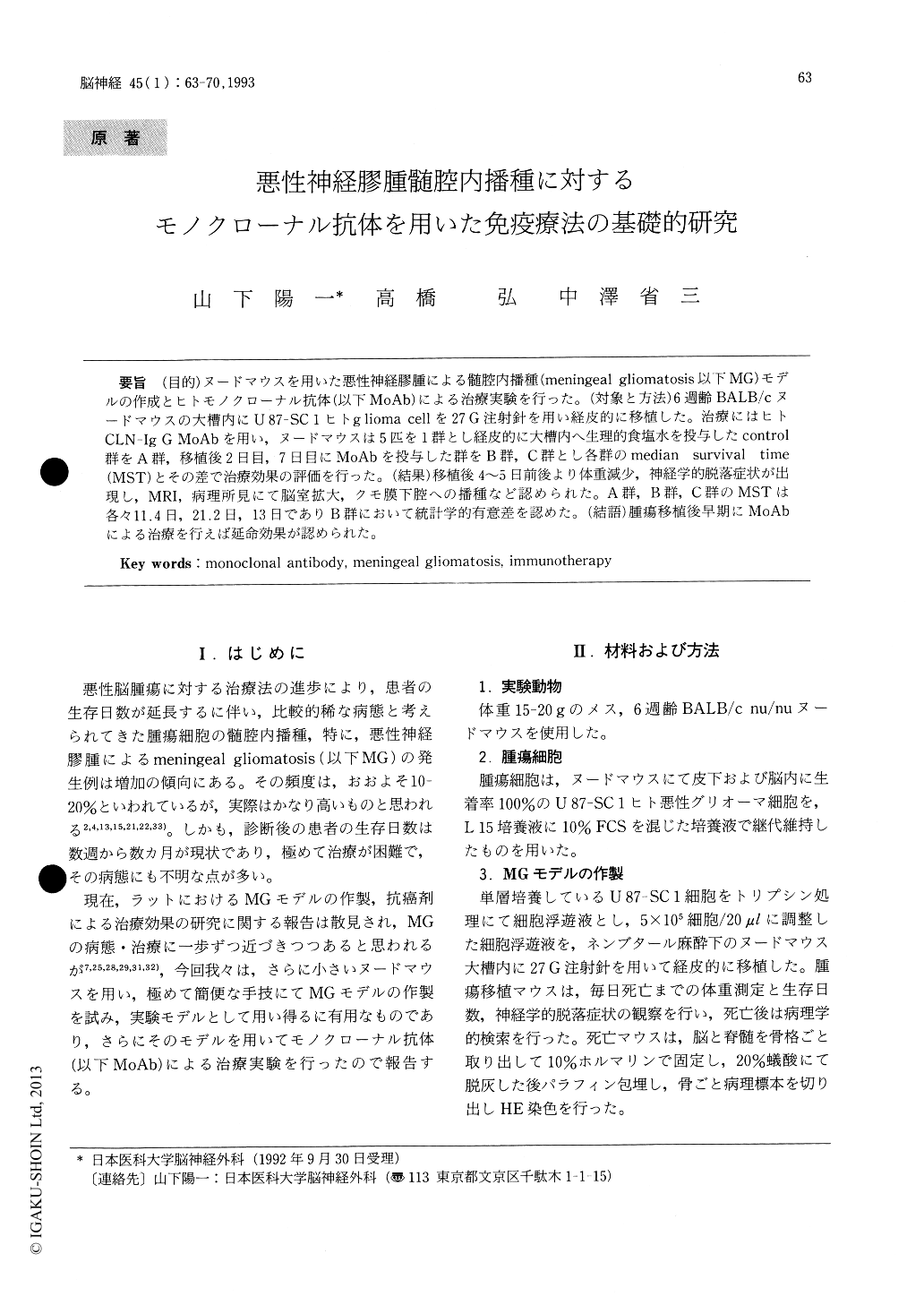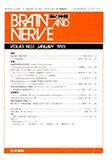Japanese
English
- 有料閲覧
- Abstract 文献概要
- 1ページ目 Look Inside
(目的)ヌードマウスを用いた悪性神経膠腫による髄腔内播種(meningeal gliomatosis以下MG)モデルの作成とヒトモノクローナル抗体(以下MoAb)による治療実験を行った。(対象と方法)6週齢BALB/cヌードマウスの大槽内にU87—SC 1ヒトglioma cellを27 G注射針を用い経皮的に移植した。治療にはヒトCLN-Ig G MoAbを用い,ヌードマウスは5匹を1群とし経皮的に大槽内へ生理的食塩水を投与したcontrol群をA群,移植後2日目,7日目にMoAbを投与した群をB群,C群とし各群のmedian survival time(MST)とその差で治療効果の評価を行った。(結果)移植後4〜5日前後より体重減少,神経学的脱落症状が出現し,MRI,病理所見にて脳室拡大,クモ膜下腔への播種など認められた。A群,B群,C群のMSTは各々11.4日,21.2日,13日でありB群において統計学的有意差を認めた。(結語)腫瘍移植後早期にMoAbによる治療を行えば延命効果が認められた。
Recently extension of malignant glioma to the spinal cord (meningeal gliomatosis : MG) has been described with increasing frequency as the adva-ncement of the therapy for brain tumor. How-ever, the study for clinicopathological features of MG has not been established and its therapy has still been difficult. We tried to produce experimental models of MG using nude mice and study experi-mental immunotherapy with human monoclonalantibody (CLN-IgG MoAb). U87-SC1 human glioma cells (5×105 in 20 μl) were inoculated trans cutaneously into the cisterna magna of BALB/c nu/ nu mice using a 27-gage needle. Daily weights neurological findings and survival time were examined. MRI scan was performed after neuro-logical deterioration and histological examination was also performed after death. CLN-IgG MoAh was used for treatment and 15 nude mice which were inoculated with tumor cells into the cisterna magna (Day 0) were devided into three groups of 5 mice each. Group A was control group which received saline into the cisterna magna, Group B and C received 50 ,μg of CLN-IgG into the cisterna magna on Day 2 or Day 7 following inoculation of tumor cells. Efficacy of experimental immunothe-rapy was statistically evaluated by the difference of median survival time (MST) among three groups. All of the nude mice lost weight within 4 or 5 days after inoculation of tumor cells and developed para-plegia or tetraplegia with incontinence and died. MRI of the nude mice which showed neurological deteriorations revealed ventricular dilatation, infiltration of tumor cells to the spinal cord and spread of tumor cells into the subarachnoid space. Pathological features were similar to the findings seen in MRI. MST of Group A, B and C were 11.4, 21.2 and 13 days respectively. Group B resulted in an increase in MST compaired with control group (p< 0.05) . These studies showed these models were useful investigating the pathophysiology of MG and the efficacy of immunotherapy or other therapies. The treatment with CLN-IgG MoAb before the progress of proliferation and infiltration of tumor cells to the brain and spinal cord is also shown the prolongation of the survival time of MG model by these studies.

Copyright © 1993, Igaku-Shoin Ltd. All rights reserved.


